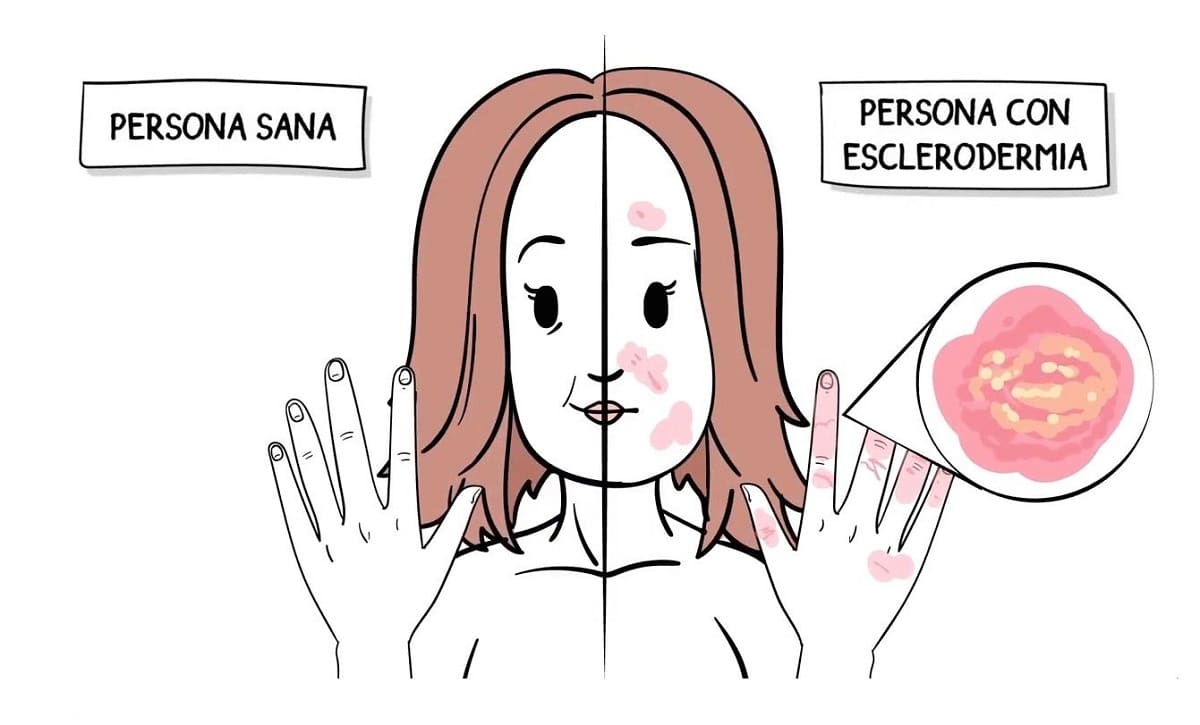
Scleroderma is a autoimmune skin disease. It is characterized by a progressive hardening of the skin. Is a weird illness, whose development is very complex and which is not yet totally clear. It affects between 200 and 300 people in every million.
We tell you what the causes are, its symptoms, the treatment that is being used the most, and above all we will emphasize how scleroderma affects those under 16 years of age. First, we want to indicate that in this article, as many professionals do, scleroderma and systemic sclerosis are going to be used as synonymous terms.
What is scleroderma or systemic sclerosis?

We have already advanced that scleroderma or systemic sclerosis is a skin disease of autoimmune origin, in which there is a progressive hardening of the skin, and in which the internal organs and vessels are also affected. There is a set of diseases, with different clinical manifestations, which are related by the presence of stiffness of the skin, which are called systemic sclerosis.
There are no data on the exact number of boys and girls with this disease, but it is estimated that 50 children out of 100.000 will develop localized scleroderma. This is the most common form of the disease in children under 10 years of age, and affects more girls. Systemic scleroderma in children is less than 10% of all scleroderma.
Although the cause of scleroderma is unknown, it appears that genetics play an important role. The most widely accepted theory is that genetically susceptible children, that is, those with certain genes, when exposed to certain environmental factors, be they chemicals or infections, activate the pathological processes that ultimately lead to disease. systemic scleroderma.
Type of scleroderma that affects children the most

Scleroderma is broadly divided into two forms, depending on the degree of involvement of the internal organs: localized scleroderma, and systemic sclerosis. The first, the most “common among children” is limited to the skin and in some cases extends to the muscles, joints and bones, which in children can affect the growth of bones and joints-
La Linear scleroderma, as a subtype of localized, is a common form in children. It is generally active for two to five years, but can sometimes last longer. It is characterized by thickening lesions of the skin in bands or lines. It usually appears on the trunk or limbs and is only limited to the middle of the body. A typical linear scleroderma is the so-called saber blow injury.
La Morphea scleroderma is the most common clinical form. In children they are seen as areas of thickened skin, usually oval in shape, with a whiter center and violet edges. Over time they become more brownish. These lesions appear most often on the trunk and limbs. It is dedicated to these types and to systemic sclerosis at the end of June 29, the world day of this disease to make it better known.
Treatment and other issues

The trigger for this process is not known. But sclerosis it is not contagious, nor hereditaryAlthough genetic factors play a role, it does not constitute a cancerous disease. It occurs at any age, although it is exceedingly rare in those under 10 years of age.
Though i could considered as a “benign disease”, with fundamentally aesthetic consequences, then it becomes more complicated, affecting the internal organs, until it reaches a systemic scleroderma, very rare in children and adolescents.
As general treatment measures it is recommended avoid exposure to cold, trauma, and stress. Regarding the drugs that are applied, there are disparate results, it must be the medical team who best assess the situation. In adolescence, psychological support is recommended, and always early rehabilitation to avoid permanent contractures. Hydrotherapy is widely used as a treatment, with underwater jets and general exercises in the pool at 36.5 ° C for 15 minutes.